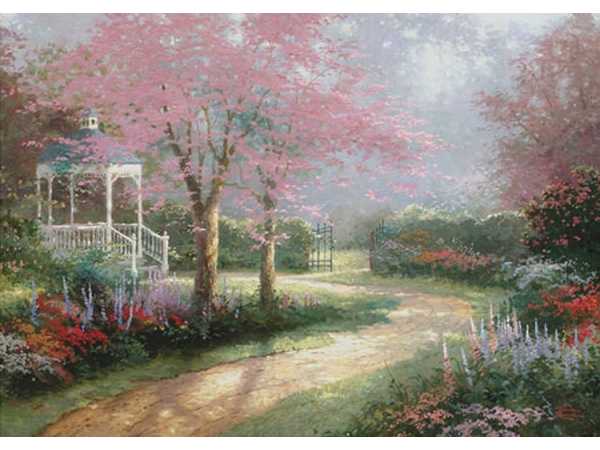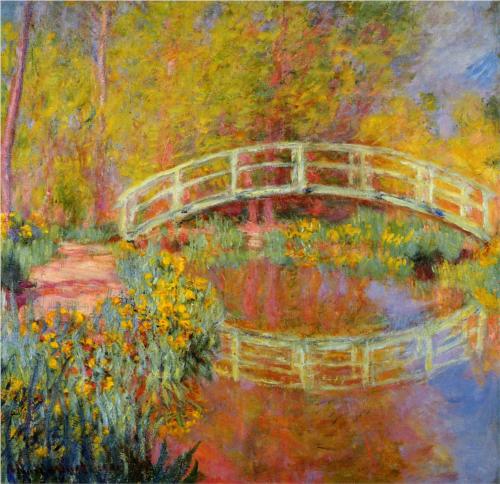
Suggestion and Delineation

Throughout the ages, art has transformed. Brushes gained more variety and styles became revolutionized through the changing of religious perceptions. Innovative artists paved the way towards this transformation. Even though art has changed, it is still remarkable to compare the styles of artists who lived in different centuries. For example, the artworks of Thomas Kinkade and Claude Monet. Thomas Kinkade has a very modern style, which makes it very interesting to compare one of his works with that of Claude Monet, an artist who thrived in the early 1900’s. Existing in completely different time periods, it would make sense that they are very different artists. The interesting part is how some aspects of their work are also quite similar. Both artists have a variety of landscape paintings, such as Morning Dogwood by Kinkade, and The Bridge in Monet’s Garden by Monet. Differences and similarities can be found in their style of art, the content of their paintings and also their personal contexts.
Looking at the works of art side by side, it is clear that very different techniques were used. Kinkade’s style requires a steady hand and a fine brush or pencil to get the details just right. The production of a Kinkade painting is a long process. He often sketched his ideas first, and then used a machine to blow up the sketch image or sometimes he even printed the images directly onto the canvas. Once the sketch was on the canvas, the painting began. Various brushes are used to get the desired affects. After painting with acrylic or vinyl based paints, Kinkade finished his work with oil paints. There is a waiting period during the transition from acrylic to oil paint so as not to ruin the image. The oil paint is used to add depth to the detail. Kinkade also used a fine point air brush for hairline detail and accents. The air brush creates a “haloing” affect and softens areas in the painting ("Thomas Kinkade - Inside Ivy Gate Studio").
Monet’s style of painting is very different from this. Although Monet also used oil paints, his style was a la prima (meaning all in one go). Monet’s whole painting was done in one sitting; there was no waiting for things to dry. Unlike Kinkade, who mixed his colors on a pallet, Monet mixed his on the canvas. Colors could mix because they had no exact location. Monet liked the way the colors blended together which is why painting over an area that was still wet did not disrupt his finished product. However, Monet never thoroughly mixed his colors; this created the blend of color that Monet wanted. Monet was also very limited in his color selection which is why blending paints on the canvas was a good way to make more colors visible. Also, Monet only used one brush to create his painting. The flat ended brush had just been invented, and this is what Monet used for his marks. His used a tache technique (French for touch) where the brush just touches the canvas, creating slabs or rectangles of color ("Paint Like Monet: A Beginner's Guide”).
Aside from their contrasting styles, the content of their paintings can be compared as well. Both artists created a variety of landscape portraits. Kinkade’s Morning Dogwood is an image of a path going by a gazebo surrounded by pink blossoming dogwoods. Although the painting portrays an early morning, the way the painting darkens towards the borders creates a cozy feelings. This cozy feeling is established in many of Kinkade’s artworks. Kinkade strives to create a setting that the viewer would desire to visit. He makes his art realistic enough so that the viewer can literally imagine themselves being there. On the other hand, The Bridge in Monet’s Garden leaves much more to the imagination. Monet’s loose brush strokes suggest rather than delineate, allowing the reader more room for interpretation. The trees and the sky in the background almost blend together, as do the pond and the grass surrounding the land. Nothing is exact, it almost appears as an image from a dream.
Interestingly enough, Monet’s painting looks like a dream but is actually real, whereas Kinkade’s painting looks extremely lifelike, but is completely fictional. The majority of Kinkade’s paintings are imaginary places that he came up with. He wanted to create places with an atmosphere that made viewers feel happy or at home. He would get inspiration from virtually anywhere, and then add on to it as it went from idea, to sketch pad, to canvas. For example, Morning Dogwood’s original inspiration came from a tree shaded gazebo in Hawaii, eventually Kinkade changed the original trees to be blossoming dogwoods, and added on more imagined details such as the path leading through a gate ("Thomas Kinkade Shop Online”). Kinkade was a religious man, and believed that you could never solidify a painting right away, you had to allow time for God to make his impression before the final outcome ("Thomas Kinkade - Inside Ivy Gate Studio”).
Monet’s paintings come from real images. The artworks were completed as he observed what it was he was going to draw. None of his artwork was imaginary; instead, he let his style of painting allow viewers to manipulate the picture. The majority of Monet’s inspiration came from his own backyard. When Monet wasn’t painting, he was landscaping. He created his own art in his backyard, and then captured it on a canvas for everyone to see. He would create multiple paintings of the same scene at different times in the day to show the changes in lighting. The Bridge in Monet’s Garden is just one of many different bridge paintings. This is also the case with his water lily paintings. Since Monet uses impressionism, and gives the effect without the detail, it is hard for two works to come out looking the same. The lack of detail and the blending of different colors on the canvas create a different affect each and every time.
Kinkade and Monet both created numerous landscape paintings, and they both tended to use oil paints. Their context and the techniques that they used were different which lead to completely different artistic outcomes. Kinkade’s attention to detail and desire to place his viewers in his imaginary landscape delineates the attention of the viewers. Monet takes real images (even from his own backyard) and aims to achieve an affect rather than putting detail in his painting. By doing this Monet’s art suggests what the readers should be seeing rather than having the image be set in stone. Both artists, though both very different, are both very talented.


========================================
Works Cited
"The Bridge In Monets Garden." Claude Oscar Monet. N.p., n.d. Web. 31 Mar. 2013. <http://www.claudemonetgallery.org/The-Bridge-In-Monets-Garden.html>.
"Paint Like Monet: A Beginner's Guide." YouTube. YouTube, 20 Feb. 2012. Web. 31 Mar. 2013. <http://www.youtube.com/watch?v=-Ftb1mkN30g>.
"Thomas Kinkade - Inside Ivy Gate Studio." YouTube. YouTube, 05 Nov. 2012. Web. 31 Mar. 2013. <http://www.youtube.com/watch?v=PAA7VeTa2js>.
"Thomas Kinkade Shop Online." The Thomas Kinkade Company. N.p., n.d. Web. 31 Mar. 2013. <http://www.thomaskinkade.com/magi/servlet/com.asucon.ebiz.catalog.web.tk.CatalogServlet?catalogAction=Product>.
========================================
Shaylen Sharp
Major: Kinesiology
Minor: Psychology
I never really understood art in the past, and writing was never my strong suite. After taking this class I learned a great deal about art and gained a sincere appreciation for it. This newfound appreciation made writing about the topic much easier, and even quite interesting. I now look at art differently, and enjoy the aesthetical aspects as opposed to just surface value.